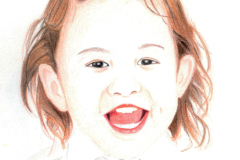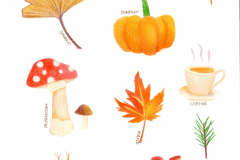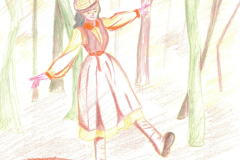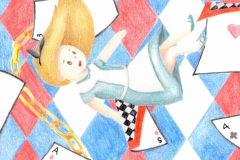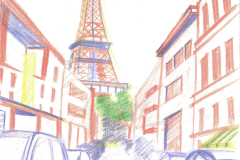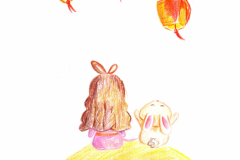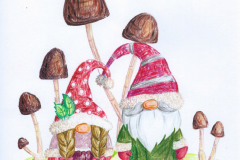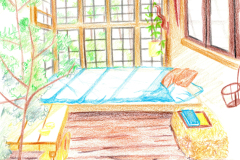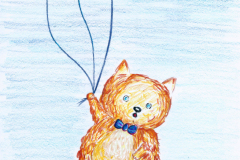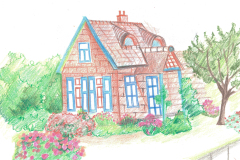Introduction
Immersive city sketch adventures invite you to explore urban landscapes through drawing. This practice blends creativity with observation, helping you see your city with fresh eyes. Whether you are a beginner or have some drawing experience, city sketching offers a unique way to connect with your surroundings.
In this article, you will learn practical tips and techniques for sketching the city. We will explore how to select subjects, choose tools, and develop your own style. These insights will help you turn everyday city scenes into compelling sketches that capture life and movement.
Choosing the Right Spot to Sketch in the City
Picking where to set up for a city sketch can feel tricky at times. You want somewhere easy to reach—no long hikes or complicated transit changes—and comfortable enough to linger, whether you’re sitting or standing. Comfort matters more than you might expect. For example, a park bench can be a perfect base, offering shade and a clear view of trees, people, or nearby buildings. Streets with interesting architecture or lively markets can spark creativity, but standing there for too long might get tiring or distracting.
Markets are great because they’re bustling with movement, colors, and characters, but you might need to be quick and flexible in your approach. Landmarks often draw crowds, so finding a quieter corner nearby might work better. I once found myself sketching the back alley of a famous square because it was quieter and revealed unexpected angles.
Keep in mind what you want to focus on. Are you after rich textures like brick and ironwork? Or people interacting? This will guide your choice. Some spots look perfect from afar but feel chaotic up close—and that can be inspiring or frustrating depending on your mood.
Safety and Comfort During City Sketching
Sketching outside isn’t just about capturing the scene—it’s about feeling safe and staying comfortable long enough to get the work done. Weather changes quickly in cities; a sudden sun can glare or a breeze can scatter your papers. Light layers and a hat usually help me stay ready, no matter the day.
Try to carry only what you need. Heavy bags slow you down and make it harder to move if you need to. I’ve learned to limit my gear to a simple pouch of essentials—pencils, pens, a sketchbook, maybe a small water bottle. Being aware of your surroundings matters. It’s easy to get lost staring at your page, but staying alert helps avoid accidents and keeps you in control.
Choose spots with some foot traffic but not so busy that you feel trapped or watched constantly. It’s a balance. And if you change locations often, keep your belongings close and protected. Little precautions can prevent bigger issues.
How to Find Unique Urban Views
City sketching isn’t just about the obvious scenes. Sometimes the best ones hide waiting for you to notice. Look up occasionally—the tops of buildings, roof lines, or window details often have shapes and shadows worth sketching. Patterns on walls, cracks in sidewalks, or even the quirks of street signs can surprise you.
Quiet corners away from crowds can reveal a side of the city you might miss otherwise. I’ve stumbled on small courtyards or narrow alleys that hold a strange stillness, giving a fresh perspective compared to busy plazas.
Don’t hesitate to spend a few minutes just observing. What draws your eye? Could a combination of simple elements form an interesting composition? Sometimes the best sketches come from these small discoveries rather than the most famous or grand views.
Essential Tools for Your City Sketch Kit
When you head out to sketch in the city, packing light matters more than you might think. Carrying heavy gear can bog you down, making you less likely to stay focused or explore spontaneously. A simple kit with a few well-chosen items usually works best.
Start with a sketchbook that fits your style and mobility. You’ll want something durable that can handle quick sketches and travel wear and tear. A smooth, mid-weight paper can balance detail and shading without bleeding through if you use ink.
Pencils and pens both have their moments. Pencils offer the chance to plan and adjust—great for rough outlines or shadows. Pens lock in your lines and push you to commit, which some find freeing and others a bit intimidating. If you want to experiment, try using both in the same sketch.
Don’t overlook comfort. A foldable, lightweight stool or portable chair makes a big difference during longer sessions. Standing gets tiring; sitting lets you settle into the scene. Small things—like a compact sharpener or eraser—round out your kit. You might never use every tool every time, but having options helps you adapt as the city changes around you.
Basic Drawing Techniques to Capture City Life
When you first look at a busy street or a cluster of buildings, the sheer amount of detail can feel overwhelming. But here’s the trick: start small, really small. Focus on simple shapes like rectangles for buildings, triangles for roofs, and circles or ovals for rounded elements like domes or street lamps. This helps you avoid getting lost in the mess of details.
Try breaking down complex structures into these basic pieces—think of a row of windows as evenly spaced squares or rectangles. It makes the scene less intimidating and speeds up your sketching. I’ve found that doing this also trains your eye to catch proportions better, even if you don’t intend to finish a perfect drawing.
Lines are your best friend in city sketching. Straight lines draw edges and outlines—think building corners or street edges—while curved lines suggest softer forms, like trees or arches. Don’t overthink every line; sometimes a loose, uneven line conveys movement and life better than a straight, rigid one.
Adding depth is where perspective kicks in—and it’s simpler than it sounds. Start with one-point perspective: pick a spot on your page as the vanishing point and draw lines that converge there. Streets and building edges usually follow these lines, guiding the eye into the scene. Two-point perspective adds complexity with two vanishing points, often used for corner views. It might feel confusing at first, but practicing this helps your sketches pop off the page rather than looking flat.
Have you noticed that sometimes breaking these ‘rules’ actually makes a scene feel more lively? A building slightly out of proportion or lines that don’t quite meet can add character, not just mistakes. Don’t be afraid to experiment as you get the hang of these basics—the point isn’t perfection, but capturing the city’s energy through your observation.
Adding Details that Bring Sketches to Life
Details are what pull a sketch out of flatness and give it character. When you look at a building, notice more than just its shape. Windows, for example—each has its own story. Some might be cracked or fogged, others clean and modern. Try capturing their variations instead of drawing identical squares. Texture matters too. Rough brick, smooth glass, peeling paint—all these surfaces tell you about the city’s age, mood, even weather.
Don’t forget people. They aren’t just blobs or stick figures. Watch how they carry bags, how their clothes fold, how they lean or rush past. Sketching them may feel tricky, but a few quick lines can suggest posture and emotion. Shadows play a crucial role here, too. Shadows under people or from awnings anchor them to the ground. Pay attention to where the shadows fall and how deep or soft they are. Those subtleties make your urban scene feel real rather than staged.
Capturing Movement and Activity
Sketching life in motion can feel… intimidating. Yet, it’s exactly what gives your cityscape energy. Try rapid, loose strokes to capture people walking or cars speeding by. The key is to avoid over-detailing. Instead of drawing every feature, focus on overall gesture and posture—maybe a bent elbow or a lifted foot. I often find myself tempted to wait for people to stand still, but that’s when sketches lose their spark.
Vehicles offer other challenges: tires blur, reflections shift, even light changes on their surfaces. Keep your lines fluid and your shapes simple. Sometimes, blurring or suggesting movement with faint lines around wheels or limbs works better than a static detailed drawing.
Using Light and Shadow Effectively
Light can transform a sketch from flat to dimensional. Watch how sunlight hits different surfaces. Does a wall glow warmly or fade into a cool shadow? Experiment with contrasting dark and light areas to suggest depth. Shadows are not just black patches; they carry shape and texture. For instance, tree shadows cast patterned light on sidewalks, adding complexity and interest.
Try drawing with a focus on where light originates. You might find certain parts of your sketch push forward—like sunlit corners—while others recede. Don’t be afraid to exaggerate shadows a bit; it helps clarify form. I sometimes hesitate to darken shadows too much, worried about losing detail, but often it gives the piece more life than I expect.
Developing Your Own Sketching Style
Finding your personal style takes time, and it rarely arrives in a neat package. It involves a lot of trial and error—sometimes you cling to a technique for weeks, other times you abandon it just as quickly. The key is to keep sketching, even when your work feels inconsistent or confusing.
Try mixing what you see in other artists’ work with what feels natural to you. For example, you might admire how one artist captures shadows, but prefer another’s rough line work. Combining bits from different sources can lead to something unexpectedly yours.
Look closely at sketches that catch your eye—what about them stands out? Is it the loose strokes, the color choices, or the way they frame a scene? Ask yourself why certain styles resonate and which parts you want to explore yourself. But beware of copying too much; it’s okay to borrow, just don’t lose your own voice.
Experiment with various tools. Pens, watercolors, markers, even digital apps can shift your approach. Some days, ink and washes might feel right, other days a simple pencil works because you want to focus on shapes rather than colors. Giving yourself permission to try and fail feels important—each medium forces you to see the city differently.
What kind of sketching brings you joy? Are you drawn to quick impressions or detailed studies? Does your work lean towards realism, or does abstraction sneak in? These questions might not have clear answers, but asking them helps you refine your direction bit by bit.
Overcoming Challenges in City Sketching
Sketching Quickly and Effectively
City sketching usually means racing against the clock. Light changes, people move, buildings get crowded with passing shadows. So, the trick is to sketch fast but don’t lose what makes the scene special. Start by focusing on big shapes first — like the outline of a building or a tree—then add smaller details if time allows.
Try to simplify. You don’t need to draw every window or brick. Capturing the feeling of the spot is often more important than perfect accuracy. A few loose lines can suggest a whole crowd or bustling street. Using shorthand symbols or quick notes might help you remember colors or textures later.
Sometimes it feels frustrating not to finish a drawing, but remember, quick sketches are a way to train your eye and hand together. The faster you sketch, the easier it becomes to recognize what’s really essential.
Dealing with Crowds and Noise
Busy streets can be overwhelming. Noise, movement, and curious onlookers distract easily. But there are ways to keep your focus. Find a spot slightly off the main path, like a quiet bench or a corner café, where you can observe without the rush right around you.
Earbuds with calming music or city sounds on low volume help me when street noises get too much. Of course, some prefer silence; it’s worth testing what helps you stay calm.
If people stop to watch, I remind myself it’s part of the experience and even an opportunity to share your passion. Sometimes talking to strangers about your work makes the atmosphere less stressful. Still, if it feels intrusive, a subtle barrier like a notebook held high or a focused gaze can politely keep distractions off.
Focus is tricky but managing your environment and setting small goals for each sketching session makes a difference. What’s the one thing you want to capture here? That question stops your mind from wandering amid all the city noise.
Using City Sketching to Explore Urban History
Sketching buildings and landmarks can do more than capture their shapes—it reveals layers of the past tucked into the city’s fabric. When you sketch an old façade or a worn statue, you aren’t just drawing; you’re noticing details that often go unseen. The textures of aged brick, the design of windows, or the weathered signs might tell stories about different eras or events. In that sense, sketching becomes a form of active looking, a way to record local history through your eyes and hands.
Some sketches become visual records of architectural styles. Others hint at socioeconomic changes—like a factory turned loft or a forgotten monument. You start to sense how history lingers visibly, even if you don’t have formal training. My own experience was surprising; a quick sketch of an old bookstore led me to discover the building once hosted a famous writer’s readings. Sketching can connect you to those narratives, almost without trying.
Researching Historical Sites to Sketch
Before heading out, doing a bit of homework sharpens your focus. Look for local history archives, city websites, or even library records. Sometimes, plaques or signs near the building offer clues, but online resources often provide richer detail. You may find old maps, photos, or stories that bring context to what you’re sketching.
Choosing meaningful subjects—those with layered histories or cultural significance—adds depth to your work. Ask yourself: what makes this site worth drawing? Is it rare, endangered, or linked to an important event? When you pick a subject with a story, your sketches carry more weight and invite viewers to look closer, wondering what you saw that day.
Adding Storytelling Elements to Your Sketches
Your sketches don’t have to be static copies. Including elements that hint at the story can make them more engaging. For example, adding people interacting with the space, signposts with dates, or small details like ivy creeping over a cracked wall can suggest passage of time or changing use. You can even jot down a few notes nearby—dates, names, or brief impressions—to make the story clearer.
It’s about capturing more than just appearance. Showing wear and tear, or adding shadows where something once stood, invites viewers to imagine or ask questions. A sketch can become a snapshot of everyday life merged with history—a reminder that cities are living stories, always changing, layered in memory and meaning.
Sharing Your City Sketches with Others
Sharing Your Work Through Social Media, Local Art Groups, and Sketching Meetups
Posting your city sketches online can feel a bit daunting at first. But platforms like Instagram or Facebook offer quick ways to share snapshots of your progress. You don’t have to be perfect or finished—sometimes raw sketches spark the most interesting conversations. Local art groups, whether online forums or neighborhood clubs, provide more focused audiences. They often welcome newcomers, so don’t hesitate to join. Sketching meetups, on the other hand, are great for in-person exchanges. Watching others draw and sharing your own work right there can be motivating. You might find yourself suddenly inspired—or simply relieved that others struggle with the same frustrations. Trying out a few of these methods will help you see what fits your style and comfort level best.
Building a Sketching Community
Joining a group is about more than just showing off your sketches. There’s a bigger benefit here—feedback and motivation. When you share your work regularly, you get fresh eyes on it. People might notice details you missed or suggest techniques you hadn’t thought of. That kind of input can push your skills forward. At the same time, being part of a community keeps you engaged. Sketching alone sometimes leads to stagnation or doubt. But when you have peers who understand the challenges, a little encouragement can go a long way. Also, seeing other artists’ progress—both fast and slow—reminds you this is a journey, not a race.
Presenting Your Sketches in Exhibitions
Preparing your city sketches for an exhibition takes some thought. You want your work to look clean and intentional, so consider mounting or framing each piece neatly. Choose pieces that tell a story—like a sequence of sketches from one day or different views of the same spot. When you talk about your art at exhibitions, focus on what drew you to those scenes, or what you noticed that others might overlook. Sharing these observations often resonates more than just the technical side of sketching. People often connect with the curiosity or the little discoveries behind the lines. That makes your presentation feel genuine—even if you’re nervous about speaking. It’s really about inviting others to see the city through your eyes.
Making City Sketching a Daily Habit
Getting into the rhythm of daily city sketching can feel tricky at first. Maybe you’re not sure when or where to fit it in. Yet, making sketching part of your routine really helps your observation skills grow steadily. The key is to start small—five or ten minutes while waiting for the bus, during your lunch break, or even standing outside your favorite café. It doesn’t need to be a masterpiece. Quick, rough lines can still teach your eye and hand to connect more naturally.
Try to spot little moments in your day for sketching:
- Draw snippets of a street corner on your way to work.
- Sketch the patterns of light and shadow on a building facade.
- Capture a detail—a window, a sign, a bike leaning against a fence.
Over time, these quick sessions add up without overwhelming you. The challenge? Not letting perfectionist thoughts stop you. Imperfect sketches matter—they’re progress.
Setting Realistic Sketching Goals
Goals keep you grounded. They remind you why you pick up your pen each day. But setting a goal that’s too big can sink motivation fast. Aiming to sketch entire city blocks daily might be exciting, but often it’s just not possible. Instead, try to set goals that feel doable and flexible.
Some ideas to consider:
- Sketch one new scene every other day.
- Focus on a single element, like doors or street lamps, for a week.
- Complete one sketch per day, even if it’s tiny or unfinished.
You can always adjust these goals as you learn what fits your lifestyle. Does a goal feel like a chore? Maybe it’s too much. Keep your goals personal and forgiving. Sketching should invite curiosity, not add pressure.
Tracking Your Progress and Growth
Keeping a sketch journal can feel like a double-edged sword. Sometimes it’s rewarding to look back and see how much you’ve advanced. Other times, those early sketches can provoke frustration or doubt. Still, tracking your work regularly is valuable. The act of reviewing your own sketches helps you recognize patterns in your style, spot improvements, and identify areas needing focus.
Here’s something you can try:
- Date each sketch and jot down a quick note about what you observed or tried.
- Set occasional checkpoints—once a month or so—to flip back through your journal.
- Notice which sketches capture your attention or surprise you in a good way.
As you review, you might find that your sketches aren’t as rough or hesitant as you once thought. That little realization can be surprisingly encouraging. And maybe it will spark new goals or ideas on where to take your urban sketching next.
Conclusions
City sketching turns ordinary urban views into creative stories on paper. By focusing on key details and practicing regularly, you deepen your connection to your environment. Your sketches become more than drawings; they tell the story of the places and people around you.
Try making city sketching part of your routine. Watch how your skills improve and your appreciation for your city grows. Each sketch is a step on your journey as an urban explorer and artist.



















